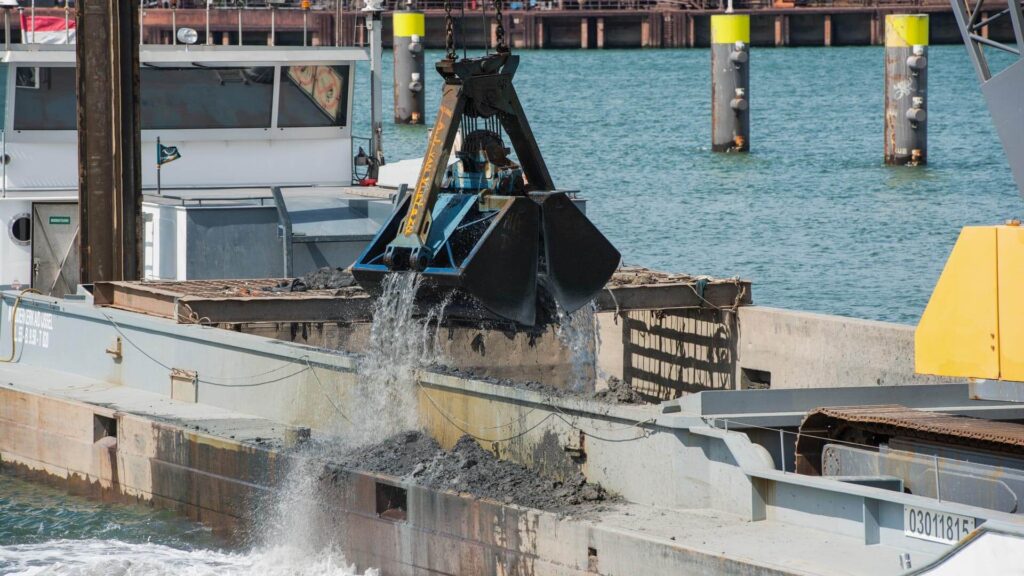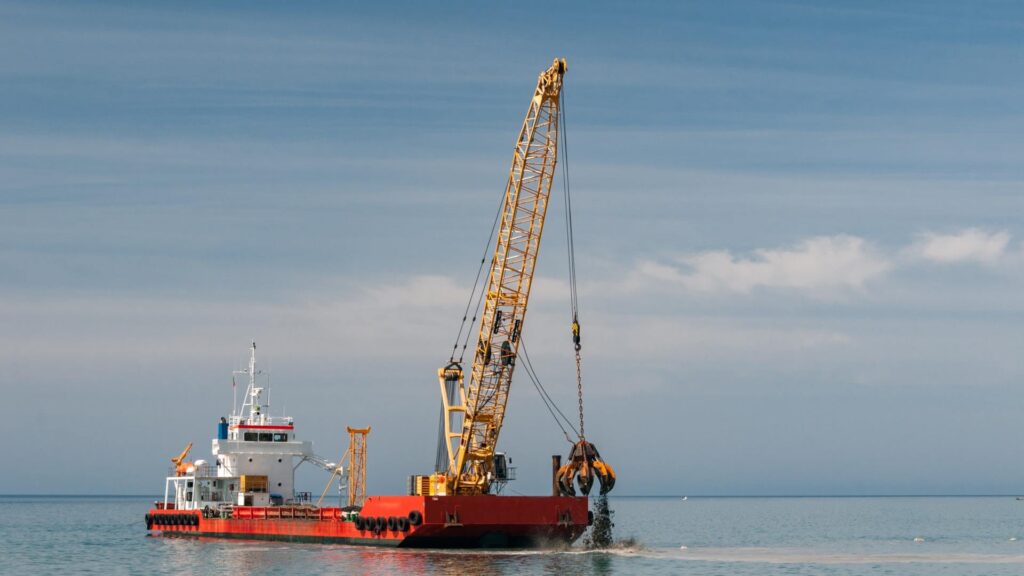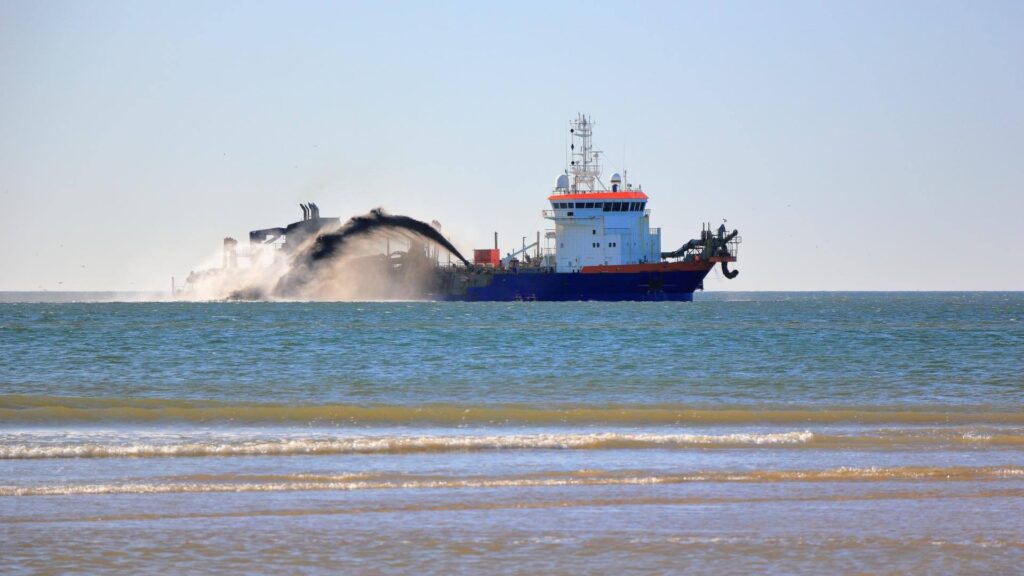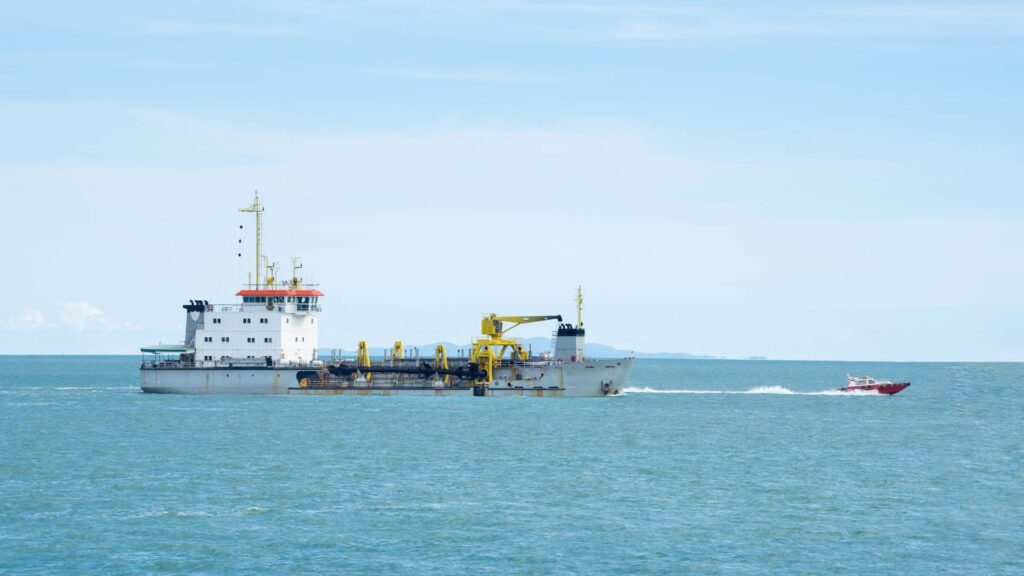Coastal infrastructure plays a crucial role in driving global trade, supporting local economies, and facilitating industries like shipping, tourism, and fisheries. Ports, harbors, and waterways serve as essential hubs, ensuring seamless connectivity and commerce. However, these critical assets face challenges from sediment buildup, debris, and natural erosion, which can obstruct channels and compromise navigability. Maintaining these waterways is vital to ensure their efficiency and safety.
Harbor dredging addresses these challenges by removing accumulated sediment and debris from the seabed and maintaining and enhancing the depth and capacity of waterways. Without regular dredging, harbors would struggle to accommodate vessels, disrupting economic activities and creating safety risks.
Modern techniques and equipment are used to effectively dredge harbor areas, clearing obstructions while minimizing environmental impacts. Harbor dredging is not just about maintenance but also plays a key role in expanding port facilities, building new infrastructure, and supporting economic growth.
As global trade expands and coastal populations grow, dredging harbor areas becomes increasingly important for ensuring functional and efficient waterways. By integrating sustainable practices, harbor dredging continues to support the development and resilience of coastal infrastructure.
What Is Harbor Dredging?
Harbor dredging is the process of removing sediment, debris, and other obstructions from the seabed to maintain or increase the depth of waterways, ensuring they remain navigable and safe for vessels. This process is essential for keeping harbors operational, particularly as sediment naturally accumulates over time due to tides, currents, and human activities. Harbor dredging plays a crucial role in supporting global trade, tourism, and local economies by maintaining efficient port operations.
Dredging harbor areas can be broadly categorized into two types: maintenance and development. Maintenance dredging focuses on preserving the current depth and functionality of existing waterways by removing natural sediment buildup. This type of dredging ensures harbors remain safe for ships and prevents interruptions in operations. Development dredging, on the other hand, deepens or widens waterways as part of infrastructure expansion. It is commonly undertaken to construct new ports, accommodate larger vessels, or reclaim land for coastal infrastructure projects.
Advanced equipment and techniques are used to dredge harbor areas effectively. These include mechanical dredgers, such as clamshell and backhoe dredgers, and hydraulic dredgers, such as cutter suction and trailing suction hopper dredgers. The choice of equipment depends on factors such as sediment type, depth, and the scope of the project. Modern dredging harbor practices often emphasize minimizing environmental impact, using techniques like silt curtains and sediment relocation to protect marine ecosystems.
Overall, harbor dredging is an essential process for maintaining and developing coastal infrastructure, ensuring safe navigation, and supporting economic growth while balancing environmental concerns.
Why Is Harbor Dredging Critical for Coastal Infrastructure?

Harbor dredging is vital for maintaining and expanding coastal infrastructure, serving as a foundation for safe navigation, economic growth, and environmental resilience. One of its primary roles is to ensure safe passage for commercial and recreational vessels. As sediment accumulates over time, waterways can become shallower and narrower, increasing the risk of grounding and accidents. By removing these obstructions, harbor dredging maintains navigable depths and protects vessels from potential damage.
Another key benefit is facilitating trade and economic growth. Ports are essential hubs for global commerce, and their efficiency depends on unhindered access for cargo ships. When harbors are well-maintained through dredging, they can accommodate larger vessels, streamline logistics, and enhance the competitiveness of coastal regions.
Tourism also relies heavily on accessible marinas and harbors. Regularly dredging harbor areas ensures that leisure boats, cruise ships, and other vessels can dock safely, boosting local tourism industries and contributing to economic diversification.
Harbor dredging also significantly enhances coastal resilience. By managing sediment buildup, dredging harbor areas reduces the risk of flooding and erosion, protecting infrastructure and ecosystems. It also allows for better water flow and ensures that harbors can withstand the impacts of extreme weather events.
Overall, the decision to dredge harbor waterways is about maintenance and ensuring the longevity and functionality of coastal infrastructure. Dredging supports safe navigation, economic vitality, and environmental sustainability, making it an indispensable practice for coastal regions worldwide.
Harbor Dredging in Infrastructure Development Projects

Harbor dredging is a cornerstone of infrastructure development, critical to the creation of new ports and the expansion of existing ones. As global trade increases, ports must accommodate larger vessels with deeper drafts. To meet these demands, dredging harbor areas deepens and widens navigation channels, ensuring that ports remain competitive and efficient. This process improves access and creates space for additional berths, cargo terminals, and supporting facilities.
Dredging is vital in coastal urban development and land reclamation projects. In many cases, dredging harbor areas is necessary to reclaim land for industrial, residential, or recreational purposes. Cities with limited coastal space can expand their usable land through dredging, enabling the development of critical infrastructure like housing, roads, and public spaces. Integrating dredging harbor operations into urban planning ensures that coastal regions continue to thrive and meet the needs of growing populations.
A notable example of harbor dredging’s impact is the expansion of the Port of Singapore. Through extensive dredging efforts, the port was deepened and expanded, enabling it to handle some of the world’s largest container ships and reinforcing its position as a global trade hub. Similarly, the Maasvlakte 2 project in the Port of Rotterdam involved large-scale harbor dredging and land reclamation to create additional port facilities, boosting the region’s economic capabilities.
From facilitating trade to enabling urban growth, harbor dredging is essential in shaping the future of coastal infrastructure, ensuring that ports and coastal cities remain adaptable and resilient in the face of growing demands.
Environmental Considerations in Harbor Dredging
While harbor dredging is essential for coastal infrastructure development, it must be conducted responsibly to minimize its ecological impact. Dredge harbor operations can disturb marine ecosystems, resuspend sediments, and affect water quality, which makes environmental management a key priority. Careful planning and modern techniques are crucial to balancing the benefits of dredging with the need for marine conservation.
One of the primary challenges of harbor dredging is managing sediment disposal. When dredge harbor materials are removed, they must be handled in an environmentally sound way to prevent harm to aquatic habitats. Sediment disposal planning often includes identifying suitable disposal sites or reusing dredged materials in beneficial ways, such as beach nourishment or land reclamation.
Another effective method of reducing ecological disruption is using silt curtains during dredging harbor projects. These barriers contain suspended sediments, preventing them from spreading and protecting nearby sensitive habitats like coral reefs or seagrass beds.
Balancing coastal development with marine conservation also involves timing dredging operations to avoid critical breeding or migration periods for marine life. Moreover, harbor dredging projects increasingly employ environmental monitoring systems to assess and mitigate any unforeseen impacts.
Implementing sustainable practices such as sediment management and habitat protection makes dredging harbor areas possible while maintaining ecological balance. When managed effectively, harbor dredging supports infrastructure growth while safeguarding marine environments for future generations.
Economic Benefits of Harbor Dredging
Harbor dredging plays a pivotal role in driving local and national economic growth by improving trade routes and port efficiency. Ports are vital hubs for global commerce, and their success hinges on their ability to accommodate larger vessels and manage increased cargo volumes. By deepening and widening waterways, harbor dredging allows for seamless navigation, reduces delays, and increases the overall efficiency of shipping operations. This improved connectivity bolsters international trade, which in turn fuels economic development in coastal regions.
Regular harbor dredging also reduces long-term maintenance costs. Sediment naturally builds up in harbor areas, restricting vessel movement and leading to potential downtime for port operations. By maintaining navigable depths through regular dredging, ports avoid costly disruptions and extend the life of their infrastructure. Furthermore, proactive dredging minimizes the need for emergency interventions, saving time and resources in the long run.
Dredging harbor areas also create significant employment opportunities. These projects require skilled labor, including operators, engineers, and environmental specialists, as well as personnel from related industries like logistics and marine construction. The need to dredge harbor areas for ongoing maintenance and expansion sustains jobs in these sectors and contributes to local economies.
Beyond directly creating jobs, harbor dredging stimulates economic activity in associated industries, such as manufacturing, tourism, and fisheries, by improving access to markets and resources. As coastal regions thrive, the ripple effect of dredging harbor operations supports broader economic stability and growth.
In conclusion, harbor dredging is not just a maintenance practice—it is an investment in economic resilience. By enhancing trade routes, reducing operational costs, and generating employment, it serves as a critical driver of economic prosperity for coastal regions worldwide.
Challenges in Harbor Dredging
Harbor dredging is essential for maintaining and expanding coastal infrastructure, but it also presents various challenges that must be addressed for successful implementation. One significant technical challenge in harbor dredging operations is dealing with hard substrates or deep sediments. Removing compacted materials or operating in deep waters requires specialized equipment and expertise, often increasing project costs and timelines. Additionally, unpredictable weather conditions and tidal variations can further complicate operations, impacting efficiency and safety.
Another major hurdle in harbor dredging is navigating regulatory requirements and securing the necessary permits. To dredge harbor areas, extensive environmental assessments are often mandated to ensure compliance with national and international standards. This can delay projects as stakeholders work to meet these regulatory conditions, which are critical for protecting marine ecosystems and minimizing ecological disruption.
Balancing infrastructure development with stakeholder interests and environmental policies presents another challenge. Coastal infrastructure projects often involve diverse stakeholders, including local communities, businesses, environmental organizations, and government agencies. Dredging harbor operations must carefully address these competing interests, ensuring infrastructure projects meet economic goals while safeguarding marine environments and adhering to conservation regulations.
Effective communication and stakeholder engagement are crucial to overcoming these challenges. Harbor dredging projects can navigate these obstacles by implementing sustainable practices, employing advanced technology, and working collaboratively with all parties involved. Despite the complexities, well-managed dredging harbor initiatives continue to play a key role in supporting infrastructure development and economic growth while prioritizing environmental protection.
Innovations in Harbor Dredging Technology

Technology advances have revolutionized harbor dredging, making it more efficient, precise, and environmentally friendly. Modern dredging equipment is now equipped with cutting-edge automation systems that enhance operational accuracy and reduce human error. Automated dredgers, such as trailing suction hopper dredgers and cutter suction dredgers, use advanced controls to streamline processes, ensuring faster and more effective results in harbor dredging projects.
The integration of artificial intelligence (AI) and data-driven solutions has further optimized harbor dredging operations. AI-powered systems analyze real-time data from sensors and monitoring tools to improve decision-making during dredging. For instance, these systems can predict sediment patterns, optimize dredging schedules, and even calculate the most energy-efficient routes for dredging vessels. This level of precision minimizes operational disruptions and maximizes the efficiency of efforts to dredge harbor areas.
Sustainability has also become a major focus in the development of dredging harbor technologies. Techniques such as sediment relocation and the use of biodegradable oils in dredging equipment are helping to reduce the environmental footprint of harbor dredging projects. Additionally, innovations like adaptive dredging, where dredging intensity is adjusted based on environmental conditions, help mitigate ecological impacts.
By combining these advancements, harbor dredging has become a more sustainable and efficient practice. The ability to dredge harbor areas with greater precision and reduced environmental impact is critical for maintaining navigable waterways and supporting coastal infrastructure development in a rapidly changing world. These innovations not only improve project outcomes but also align with the growing need for eco-conscious practices.
Conclusion
Harbor dredging is crucial in developing and maintaining coastal infrastructure. Its importance cannot be overstated, from ensuring safe navigation for vessels to supporting economic growth through enhanced trade routes. Additionally, dredging harbor areas contributes to environmental resilience by managing sediment buildup and protecting coastal ecosystems. These efforts enable ports, harbors, and coastal regions to thrive in an increasingly competitive and dynamic world.
However, as we continue to dredge harbor areas for maintenance and development, sustainable practices must remain a priority. Adopting eco-friendly dredging harbor techniques, leveraging technological advancements, and engaging with stakeholders are essential to balancing infrastructure needs with environmental conservation.
Effective dredging operations not only support economic growth by creating jobs and boosting trade but also promote environmental balance by mitigating ecological impacts. By prioritizing innovation and sustainability, harbor dredging can remain a cornerstone of coastal development while safeguarding marine environments for future generations. Let’s work toward a smarter, greener approach to dredging.


